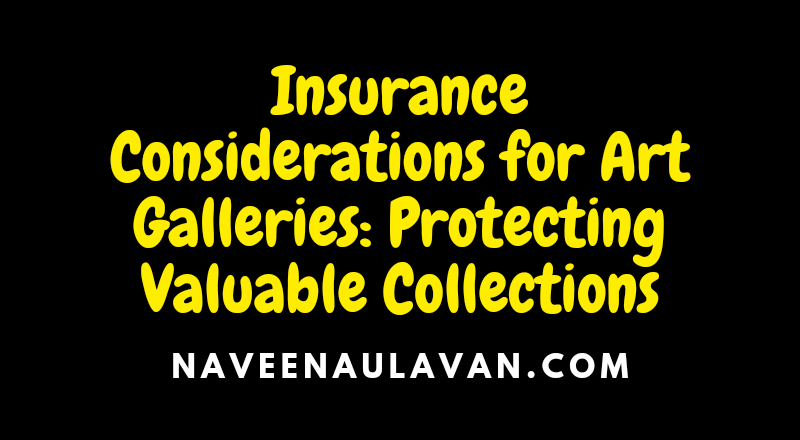Art galleries play a vital role in showcasing and preserving valuable artwork attracting art enthusiasts collectors and the general public. With the growing value and significance of art collections it becomes imperative for gallery owners to protect their assets against potential risks. One crucial aspect of risk management in the art world is obtaining comprehensive insurance coverage. This article explores the insurance considerations that art galleries should keep in mind to safeguard their valuable collections.
The Importance of Art Insurance
Art insurance provides financial protection in case of damage theft or other unforeseen events that may occur to artworks. Galleries can face a variety of risks including:
- Physical damage due to accidents natural disasters or transportation mishaps
- Loss or theft of artwork
- Damage caused during installation or deinstallation
- Damage resulting from exhibition-related activities
By obtaining an appropriate insurance policy art galleries can minimize the financial impact of such incidents and ensure the long-term sustainability of their operations.
Working with a Specialized Art Insurance Provider
Art insurance is a specialist field that requires a deep understanding of the art market valuation methods and risk factors specific to artwork. Therefore it is crucial for art galleries to work with specialized art insurance providers who have experience and expertise in insuring valuable collections.
Specialized art insurers not only have a better understanding of the unique risks associated with artwork but can also provide tailored coverage that meets the specific needs of art galleries. They can assess the value of artwork accurately recommend appropriate coverage limits and offer guidance on risk management practices to minimize losses.
Types of Art Insurance Coverage
Art insurance policies offer various types of coverage and art galleries should carefully consider their needs and select the most appropriate options. Some common types of coverage include:
- All-Risks Coverage: This type of coverage provides comprehensive protection against a wide range of risks including accidental damage theft and natural disasters.
- Transit Coverage: As artworks are often transported between locations for exhibitions or sales transit coverage protects against any damage or loss that may occur during transportation.
- Type-Specific Coverage: Some insurers offer specialized coverage for specific types of artwork such as paintings sculptures or photographs. This type of coverage takes into account the unique risk factors associated with each art form.
- Errors and Omissions Coverage: This type of coverage protects galleries against claims of negligence professional mistakes or misrepresentation. It is particularly valuable for galleries involved in the sale or appraisal of artwork.
- Business Interruption Coverage: In the event of an incident that causes an interruption in the gallery’s operations such as a fire or flood this coverage provides financial support to cover ongoing expenses and lost income during the recovery period.
Valuation and Appraisals
Accurate valuation of artwork is essential for obtaining the right insurance coverage. Art galleries should work with professional appraisers or valuation experts to assess the value of their collections. Regular appraisals are essential as the value of artwork can fluctuate over time.
Appraisals should consider factors such as the artist’s reputation historical significance provenance condition and market demand. Insurance companies may require updated appraisals periodically to ensure that the coverage and premiums accurately reflect the current value of the collection.
Risk Management and Loss Prevention
Art galleries should implement effective risk management strategies to minimize the likelihood of incidents and potential losses. Some measures that can be taken include:
- Investing in high-quality security systems including surveillance cameras alarm systems and enhanced access control
- Implementing proper environmental controls to protect artwork from temperature and humidity fluctuations
- Developing detailed inventory records with photographs descriptions and documentation of each artwork
- Regularly training staff on proper handling and installation techniques to prevent damages during transportation or display
- Implementing proper protocols for borrowing lending or loaning artwork for exhibitions
By adopting robust risk management practices galleries can reduce the potential for losses and demonstrate their commitment to protecting valuable artwork.
Policy Considerations
When selecting an insurance policy for an art gallery it is essential to carefully review the terms and conditions to ensure that the coverage adequately meets the gallery’s needs. Some key policy considerations include:
- Exclusions: Reviewing the policy’s exclusions is crucial to understand what risks are not covered. For example some policies may exclude coverage for damage resulting from war terrorism or wear and tear.
- Deductibles: Art insurance policies often include deductibles which are the amounts the insured is responsible for before the coverage kicks in. A higher deductible may result in lower premiums but may also increase the financial burden in case of a claim.
- Policy Limits: Insured galleries should carefully consider the coverage limits to ensure they adequately reflect the value of their collections. Underinsuring can leave the gallery exposed to significant financial losses.
- Policy Valuation: Art insurance policies may offer different options for valuing artwork such as agreed value or market value. Understanding the implications of these valuation methods is crucial in the event of a claim.
- Claims Process: Understanding the claims process and requirements is essential to ensure a smooth and efficient claims settlement in case of an incident. Reviewing the insurance company’s reputation for claims handling is also advisable.
Conclusion
For art galleries protecting valuable collections through comprehensive insurance coverage is essential. Working with specialized art insurance providers selecting appropriate coverage options and implementing risk management strategies are crucial steps in safeguarding artworks. By understanding the importance of art insurance and considering the various insurance considerations outlined in this article art galleries can mitigate potential risks and ensure the long-term preservation and enjoyment of their valuable collections.
